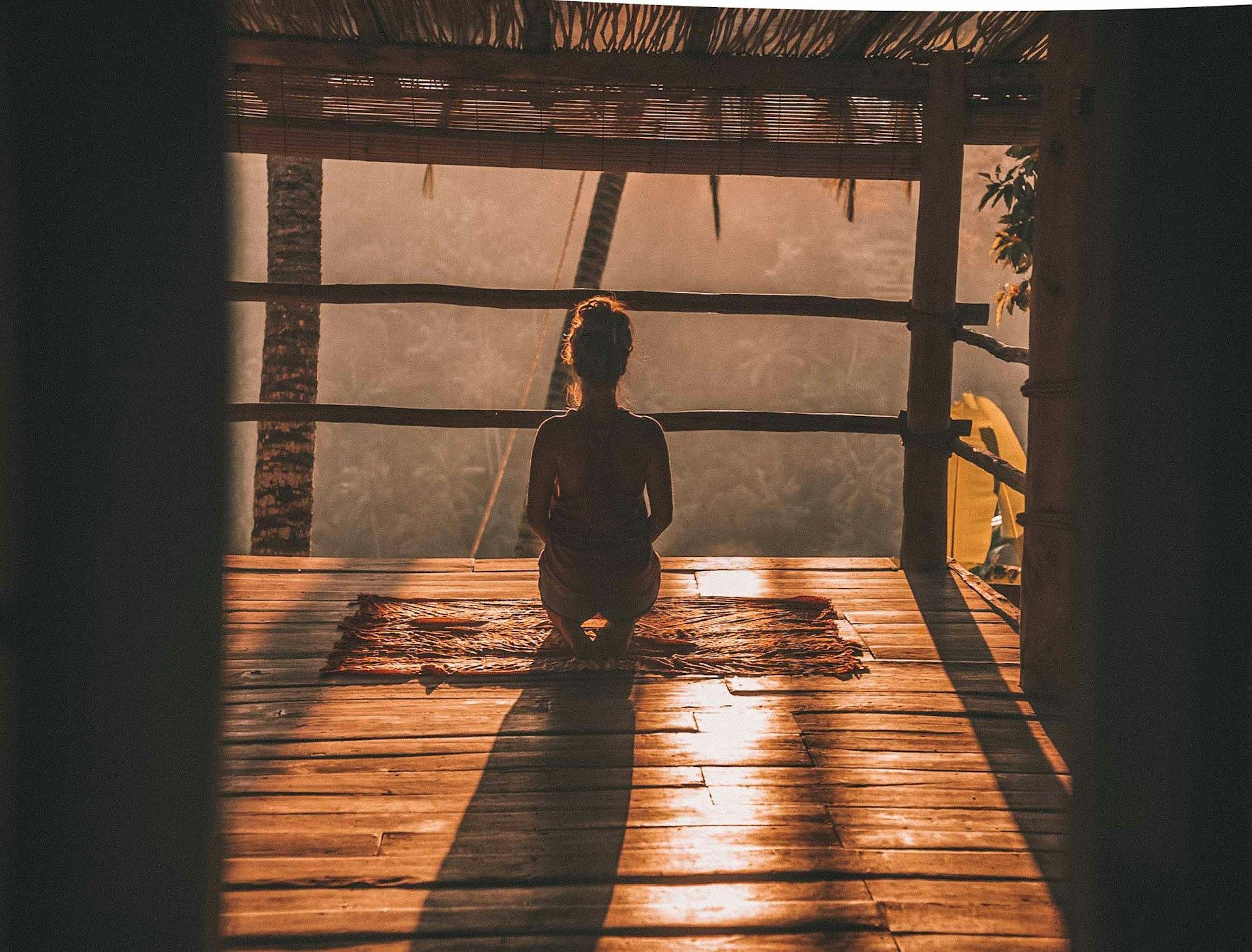Incorporating Ahimsa into Our Journey with Self-Compassion

What is Ahimsa?
“Ahimsa is a Sanskrit word meaning "non-violence." The term is derived from the root word himsa, meaning "to cause pain," and the prefix - ‘a’ means "not." Himsa (physical violence) arises out of fear, and fear leads to insecurity, which causes us to feel separate from others—alone and misunderstood” (Shah, 2020).
In Yoga, Ahimsa is the primary Yama (moral principle) that all Yogis are taught to practice both on and off the mat. Non-violence manifests into several facets of behaviors including diet (veganism), treatment of all living things (being kind to our pets), and self-compassion. When we can see ourselves in others, we are then able to fully embrace the true essence of ahimsa.
“Your trials did not come to punish you, but to awaken you,” (Yogananda, 1946).
When I contemplate my personal journey with the concept of ahimsa, I tend to focus on ahimsa towards oneself, as we cannot minimize treatment towards ourselves when we think about ahimsa. How we speak to ourselves, the narrative we tell ourselves, all these things manifest and impact us mentally, physically, and spiritually. It is my belief, that we cannot truly embody ahimsa, unless we start this practice from within.
My Personal Journey with Ahimsa
I was born with a rare genetic eye disorder called foveal hypoplasia, which causes abnormalities in the retina, leading to adverse effects on visual acuity. As a result, I am legally blind, and my vision is not correctable, which means wearing glasses, as well as any surgical procedure will not improve my vision. Involuntary rotary eye movement, called a nystagmus is another symptom of this disorder which causes me to experience frequent headaches, fatigue and imbalance.
As a child, it never resonated with me that I was different, however when I started school, and needed accommodations such as large print text and sitting up front, my classmates noticed these differences, which then brought them to the forefront of my attention, starting the decline of my self-worth. I just wanted to be like everyone else.
Wanting to be like everyone else, and very self-conscious of my disability, as I grew older, I stopped requesting the accommodations that I needed to be successful, and a result my grades declined. I was not trying my best, or performing to my full potential. As my grades progressively deteriorated, so did the narrative I told myself. I convinced myself that in fact I did not have the aptitude or intellect needed to succeed. As I look back this is one of my biggest regrets.
Changing My Mindset
After college, graduating with mediocre grades at best, I entered the corporate finance world in an entry level role. The organization I joined had what was new to me at the time, an employee resource network, one specifically for people with disabilities. I joined reluctantly, but I think what drew me in was the longing for a community that understood me. Meeting other people with a vast spectrum of disabilities, changed me. I was shown so much compassion, empathy, comradery, that over time, I started to feel and act with compassion for myself. Joining such a supportive community also gave me the gift of starting to see myself in others.
What I formerly viewed as judgment or isolation from others, I now viewed as an opportunity to build awareness and educate. Rather than feeling ashamed and self-conscious, I started to feel empowered, and proud of myself.
After shifting the lens through which I interacted with myself and others, and repetitively putting ahimsa into practice, my life significantly transformed. I had the confidence to make a positive shift in my path, deciding to return to school for my Masters degree, and graduated at the top of my class. I also began to flourish in my career.
Finding Community through Yoga
After spending many years as a practitioner, I discovered that it is part of my journey (and passion) to teach others. I studied as a disciple of Sri Dharma Mittra at the Dharma Yoga Center of New York where I completed my 200-, 500-, and 700-Hour Dharma Yoga Registered Teacher (DYRT) certifications. Dharma Yoga is unique in that it focuses not only on physical postures, but equally prioritizes breathing, meditation, and spiritual discourse, which offers a truly wholistic practice.
Being a part of the dharma yoga community has been a huge proponent in my growth as well. I always remind my students that everyone’s body is different, you know your body best, and try your best and have no expectations of results.
For me these words are a constant reminder to always treat myself with compassion, love, and not to sell myself short. If there are asanas I struggle with, that is OK, it is not about what I can do; my effort and intentions are what matters. I take those words with me off the mat and apply them in all aspects of my life.
I still experience bumps along the way in my personal and professional endeavors, we all do. I have spent many years building my voice, self-esteem, and resilience. The difference is that now, through my journey into ahimsa, I challenge myself to interpret every obstacle as an opportunity to grow, and help others to grow as well. Although we cannot control how others perceive or react to us, we can control our response. Acting with ahimsa and compassion at the forefront of mind is the most empowering gift we can give ourselves and others.
Embarking on Your Journey of Ahima and Self Compassion
As your read through my personal experience, you may wonder or even worry how to begin yours; change can feel daunting at times, especially when we are unsure of how to navigate.
Below are key considerations that helped me, and many of my esteemed mentors, yoga practitioners, and students on their respective journeys.
1. Wherever you are is exactly where you are meant to be: Everything leading up to this moment has happened for a reason and has made you who you are. There is no need to look back in regret or desire to change the past. Be thankful for who you are today, and appreciate the trials that you have overcome. Be proud of where you are, in this moment, with your practice. Yoga is not meant to be a competition; it is meant to enlighten and inspire.
2. Set your intention: As you embark on this journey, enter with an open heart and mind. Be positive, with the understanding that no one is perfect. The most important attribute of our actions, is the intentions behind them. Act with compassion, empathy, and kindness towards others, but most importantly yourself. One of my favorite yoga instructors reminds her class that what your body or mind can do today (whether that be physically or mentally) may be different from what it was able to do yesterday. Finding the balance between effort and ease is crucial to fully understanding ourselves, and accepting our limitations.
3. Repetition: We may not always achieve the desired expectation or goal in the timeframe we deem acceptable, and that is okay. We tend to be our toughest critic. Remain consistent with your practice. The body and mind require repetition to develop new and positive habits that will become a part of your journey. Earlier in my yoga journey, I became extremely frustrated with myself when I was unable to successfully move into a forearm stand. I often compared myself to other students, and thought my timeline for achieving this goal was not progressing quickly enough. Eventually, after many years of repetition, I was able to successfully move into this pose. This obstacle taught me to truly let go of the physical expectations, and to focus more on my intentions behind the actions.
4. Be Flexible: I find that some students go “all-in” immediately when embarking on their yoga journey. This can be especially difficult when we think about one’s diet. Going from eating meat to embracing a vegan lifestyle is a drastic change in behavior. I remind students to be flexible If, for example, veganism is an aspiration, perhaps start to limit meat and animal bi-product intake, allowing the body to adjust. Everyone’s journey is unique and should be designed to best suit that individuals need without forcing anything.
5. Community: Open your heart to meeting like-minded connections. Well Me Right is a great way to meet mentors, and practitioners who can help guide you on your journey. Surrounding yourself with others that share similar journeys, practices, and values helps us to remain motivated and stay on the desired path. Remain engaged in community forums, and blogs, as well as local in-person events are also great ways to stay connected to the yoga community.
About The Author
Melissa is a yoga enthusiast, practitioner, and instructor focused on studying and delivering a holistic practice of mindful meditation, pranayama, and all-levels asana. She believes that an optimal yoga experience is achieved through creating a diverse and inclusive wellness environment. She encourages her students to bring their authentic selves to class, and to embrace our differences, which are our superpowers!
Melissa embarked on her yoga journey upon the self-realization that she needed a daily reprieve from her primary profession within the corporate financial sector in New York City. Different from other genres of fitness, yoga emphasizes the value of both emotional and mental health, rather than just the physical.
Melissa studied as a disciple of Sri Dharma Mittra at the Dharma Yoga Center of New York where she completed her 200-, 500-, and 700-Hour Dharma Yoga Registered Teacher (DYRT) certifications. She is also certified with Yoga Alliance as a Registered Yoga Teacher (RYT).
In addition to her careers in corporate banking and yoga, Melissa is an animal advocate, lover, rescuer, and mom to a blue nose Pitbull named Viggo. Book a session with Melissa.
